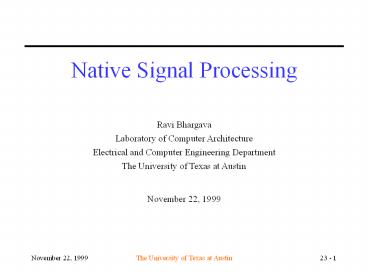Native Signal Processing - PowerPoint PPT Presentation
Title:
Native Signal Processing
Description:
First x86 NSP extensions, created for Intel's Pentium. 3DNow! ... New x86 FP SIMD for Intel's Pentium III. November 22, 1999. The University of Texas at Austin ... – PowerPoint PPT presentation
Number of Views:93
Avg rating:3.0/5.0
Title: Native Signal Processing
1
Native Signal Processing
Ravi Bhargava Laboratory of Computer
Architecture Electrical and Computer Engineering
Department The University of Texas at
Austin November 22, 1999
2
Motivation
- Need new ways to support emerging applications
- Multimedia
- Signal processing
- 3D graphics
- Many applications have similar properties
- Large streams of data
- Data parallelism
- Small data types
- Tight loops
- High percentage of computations
- Common computations (e.g. MAC)
3
Target Applications
- IP telephony gateways
- Multi-channel modems
- Speech processing systems
- Echo cancelers
- Image and video processing systems
- Scientific array processing systems
- Internet routers
- Virtual private network servers
4
Basic Idea
- Extend capabilities of general-purpose processor
- Additions to the instruction set architecture
- Additions to the CPU state
- Exploit Data Parallelism
- Single Instruction Multiple Data (SIMD)
- Multiple operations using one functional unit
5
SIMD
- Use one register to store many pieces of data
6
Packed Arithmetic
- Unsigned Packed Add with Saturation
7
Packed Arithmetic
- Multiply Accumulate
8
MMX Example
- 16-bit Vector Dot-Product
9
Dot-Product (cont.)
10
Alternative Dot-Product
- Useful in certain cases
11
Alternative Dot-Product (cont.)
- Interleaving the Data
12
Support for NSP
- Libraries
- Most common type of support
- Tradeoff speed for robustness
- Compiler
- Cant do too much, but getting better
- Can use macros, annotations, and intrinsics
- Operating System
- Needs to know about any new registers and states
- Needs to know about any new exceptions
13
Common Concerns
- Organizing SIMD data
- Packing and unpacking SIMD registers
- Shuffling data within the register
- swizzling, scatter and gather
- Permute units
- Aligning data
- Special load and store instructions
- New data types in compilers
- Padding data types
14
New Instructions
- Packed Comparisons
- Packed maximum, minimum
- Packed Average
- Packed Sum of absolute differences
- Multiply-accumulate
- Conversion signed, data length, data type
- Approximations reciprocal, reciprocal square
root - Prefetch
- Store fence
15
Evolution of NSP
- Visual Instruction Set (VIS)
- First NSP extension found on Suns UltraSPARC
- MMX
- First x86 NSP extensions, created for Intels
Pentium - 3DNow!
- Addition of FP SIMD instructions on AMDs K6-2
- Altivec
- Adds new CPU State for Motorolas G4 PowerPC
- Streaming SIMD Extensions
- New x86 FP SIMD for Intels Pentium III
16
VIS
- Uses 64-bit floating point registers
- Data formats tailored for graphics
- No saturation arithmetic
- Only 8-bit x 16-bit multiplication
- Implicit assumptions about rounding number of
significant bits - 3 increase in die area
- C Macros and MediaLib for development
17
VIS Tailored for Graphics
- Assumes pixels will be most common data
18
UltraSPARC with VIS
19
3DNow! on K6-II
- 21 new SIMD instructions
- Including floating point SIMD instructions
- PREFETCH instruction
- Approximation and intra-element instructions
- Two 32-bit FP instructions in one register
- Two 3DNow! instructions possible per cycle
- Latency of two cycles, throughput of one cycle
- Aliased to the FP registers (like MMX)
20
3DNow! on the K6-II
21
Streaming SIMD Extension
- 70 new instructions
- 8 new 128-bit SSE registers (OS support)
- Execute two SSE instructions simultaneously
- Double-cycle through existing 64-bit hardware
- 2 micro-ops per SSE instruction
- Latency often two cycles or greater
- Explicit scalar SSE instructions
- Prefetch to various levels of cache
- Non-allocating stores
- 10 increase in die area
22
Pentium III
23
3DNow! on the Athlon
- Zero switching overhead back to FP!
- Most instructions have one cycle latency
- 24 more instructions
- 12 more integer SIMD instructions
- 7 more data manipulation instructions
- 5 unique DSP instructions
- Packed FP to Integer word conversion with sign
extend - Packed FP negative accumulate
- Packed FP mixed negative-positive accumulate
- Packed integer word to FP conversion
- Packed swap double-word
24
Athlon
25
Altivec
- 162 new instructions
- Intra-element rotate, shift, max, min, sum
across - Approximations log2, 2 raised to an exponent
- No explicit SAD instruction
- Separate 32-entry, 128-bit vector register file
- Floating-point and fixed-point data types
- Instructions have three source operands
26
Altivec (cont.)
- Permute Unit
- Shuffle data from any of the 32 byte locations in
two operands to any of 16 byte locations in the
destination - Permute instructions - one cycle
- Vector Unit
- Three sub-units
- Simple fixed-point - one cycle
- Complex fixed-point - three cycles
- Floating-point - four cycles
27
Applications using 3DNow!
- 3D games and engines
- Descent 4, Diablo 2, Quake III, Unreal 2
- 3D video card drivers
- Matrox, Diamond, ATI, nVidia, 3DLabs, 3dfx
- Graphics APIs
- OpenGL, DirectX, Glide
- Other apps
- Naturally Speaking, LiveArt98, WinAMP, PicVideo,
PC-Doctor, QuickTech, XingMP3
28
Additional Information
- MMX talk and additional references
- http//www.ece.utexas.edu/ravib/mmxdsp/
- NSP talk outline and links
- http//www.ece.utexas.edu/ravib/nsp/































